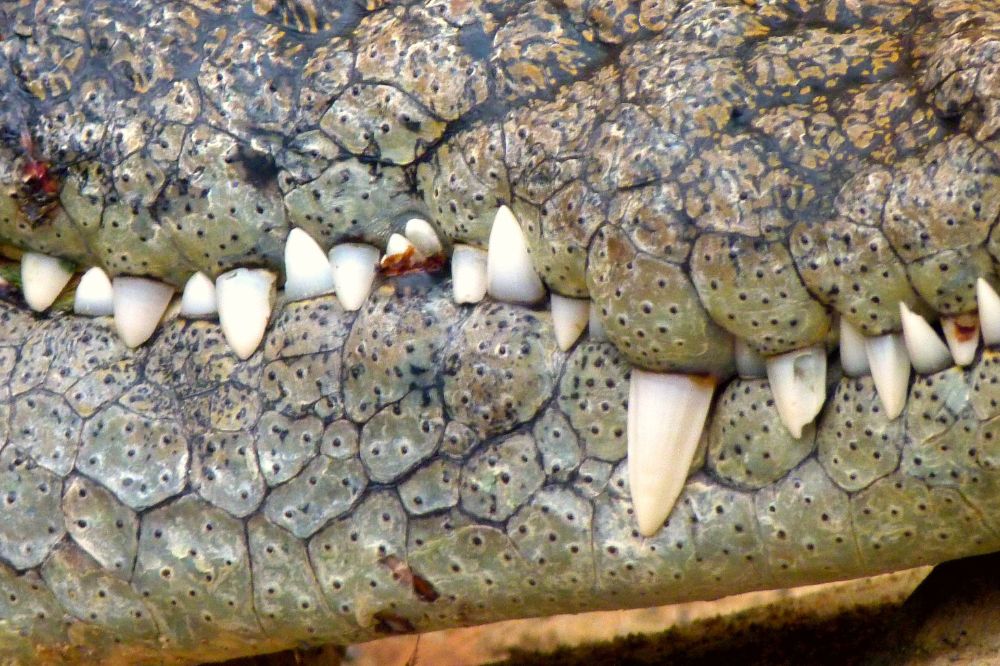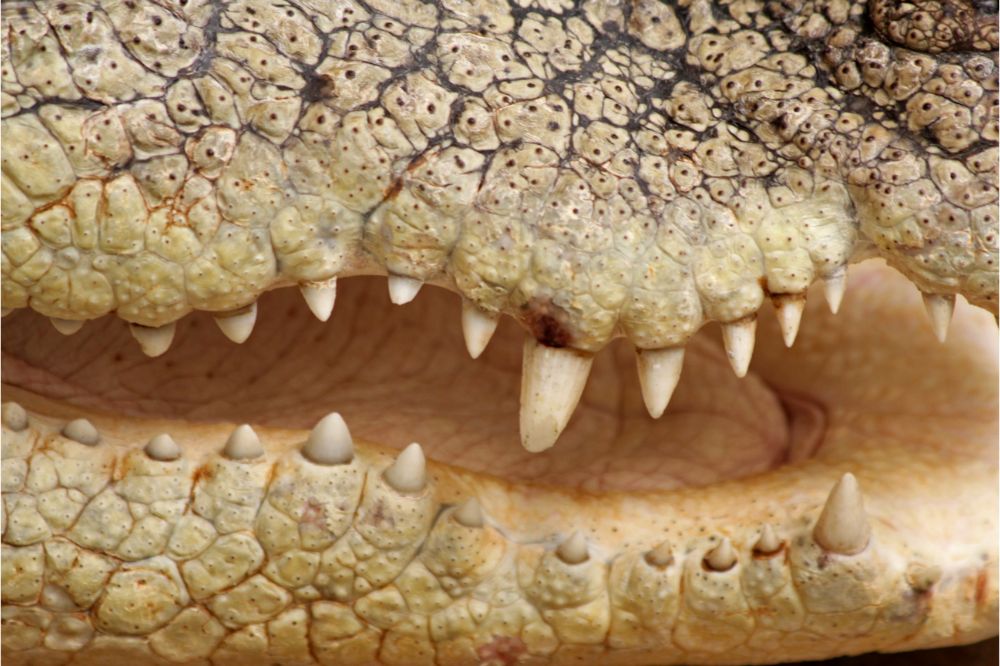Crocodiles are fascinating creatures that have been around since the time of the dinosaurs, and they have changed little since then because they are so perfectly suited to their environments.
A major part of this is related to their teeth, which have evolved to make them highly efficient ambush hunters, and to explain how and why, in this post, we answer the question, how many teeth do crocodiles have?
If you want an overview of some of the stuff we’re going to be talking about, you can also check out this video before reading on.
How Many Teeth Do Crocodiles Have? The short answer
Crocodiles’ teeth, how many they have and how they use them is a fascinating subject, but before we get into the details of the topic, let’s make things as simple as we can and start with a short answer to our question.
How many teeth does a crocodile have? Well, it depends on the species, but for example, the smallest species, the dwarf crocodile, has 60 – while the saltwater crocodile, the largest species, has 66.
However, since crocodiles are polyphyodont – a fancy way of saying their teeth fall out and grow back throughout their lives – their teeth are constantly being replaced.
A crocodile’s teeth are completely replaced every 20 months or so, and for a crocodile that lives to 75 years old, that means it will have about 45 sets of teeth in its lifetime.
So as a very rough estimate, crocodiles can get through between 2,000 and 3,000 teeth before they die.
But as we said, there’s far more to it than just this, so now let’s jump in and look at the topic in a bit more depth!
How do crocodiles hunt?
To understand more about crocodiles’ teeth, first, we need to know about how they hunt.
There are thought to be around 18 living species of crocodile, although some of them are disputed.
However, they all hunt and feed in a broadly similar way, with the main difference being the size of prey they take, which depends on the size of the species in question.
Most crocodile hatchlings feed on invertebrates and other small animals until they grow big enough to start taking larger prey. They then graduate to taking birds, small reptiles and small mammals – and then larger mammals as they continue to grow.
Generally speaking, crocodiles are ambush predators, preferring to approach their prey undetected before striking at the last moment.
Once they grab their prey in their jaws, they may then eat it whole if the prey is small enough, or they may drag it into the water where they will perform a so-called “death roll” to tear off chunks of flesh to eat – more in this later in the post.
As a result of this hunting technique, crocodiles have evolved a number of features that make them particularly well adapted to capturing their prey in this way, many of which relate to their teeth and jaws – so let’s look at this now.
How are crocodiles adapted to hunting like this?

Here are some of the adaptations crocodiles have that make them such efficiently lethal hunters.
-
Curved, conical teeth
The aim of a crocodile when hunting is to capture its prey in its jaws and then not let go, and as a result, crocodiles have curved, conical teeth, many of which are angled slightly backward.
Crocodiles’ teeth are not designed for chewing or slicing through food but rather for holding prey in place and preventing it from escaping.
As a result, this conical, curved, backwards-facing configuration is the perfect solution – once a crocodile closes its jaws on its prey, there is little chance of the stricken animal wriggling free.
-
Teeth relatively blunt
Unlike animals like sharks that have sharp teeth for biting off pieces of meat, crocodiles’ teeth are relatively blunt.
They are pointed enough to pierce the skin and flesh of their prey to hold it in place, but they don’t slice through the flesh because this would give the animal more chance of escaping, even if it meant leaving a large chunk of meat in the crocodile’s mouth.
Instead, the pointed yet blunt teeth are ideal for holding the prey in the crocodile’s mouth with no chance of escape, after which the crocodile can consume the animal at its leisure.
-
Immense bite force
The third aspect of a crocodile’s adaptation to this kind of hunting doesn’t come from its teeth but from its jaws.
Crocodiles have immense power in their jaws, so once they bite down on something, it’s almost impossible to prize their jaws open again – indeed, the saltwater crocodile has the most powerful bite in the entire animal kingdom.
This means that any animal unfortunate enough to find itself in a crocodile’s jaws is unlikely to be able to get out again unless the crocodile decides to let go.
As a result, when the configuration of the teeth and the bite power of a crocodile are combined, it becomes obvious that this is an animal that is perfectly adapted to hunting in this way, leaving its prey with very little chance of escape once the crocodile sinks in its teeth.
Crocodiles can’t chew
As we’ve noted, crocodiles’ teeth are conical in shape, so they don’t have teeth like our incisors that we use for biting off a chunk of apple, for example, and they don’t have teeth like our molars that we use for chewing – so how do crocodiles eat?
If a crocodile catches something small enough to swallow whole like a bird, then that’s what it will do – a crocodile is not fussy about consuming the bones, feathers, beak or anything else.
However, if a crocodile catches something larger – for example when a Nile crocodile sinks its teeth into a zebra or a wildebeest – it performs a death roll.
This involves the crocodile using its tail to roll its body over and over until a bite-sized chunk of meat is torn from the unfortunate victim – which the crocodile will then swallow. And if it’s still hungry, the crocodile will then simply come back and tear off another chunk.
Contrary to popular belief, the purpose of a death roll isn’t to kill the victim, the objective is simply to tear off a piece of meat to eat.
However, any animal that is subjected to this kind of attack is highly unlikely to survive or escape, so death is almost guaranteed.
There are some fairly horrific videos on YouTube of crocodiles performing death rolls, and if you want to watch those, you can search for them yourself.
However, here’s a video of a crocodile performing a death roll during feeding time that demonstrates their awesome power.
Interesting fact
Interestingly, although crocodiles have immense bite power, since they don’t chew, the muscles for opening their mouths are largely undeveloped.
This means it is easy to hold even a large crocodile’s mouth closed with your bare hands, and a crocodile can easily be restrained with nothing more than a few wraps of duct tape around the jaws.
FAQs
-
How many species of crocodile are there?
There are thought to be around 18 species of crocodile, although the exact number is disputed since some species are arguably just sub-species of more established species of crocodile.
-
What is the largest species of crocodile?
The largest crocodile species in the world is the saltwater crocodile (Crocodylus porosus), which can grow up to 20 ft or more in length and weighs between 2,200 and 3,300 lbs.
They are found in brackish water from India’s east coast, throughout Southeast Asia and right down into Australia. However, it is now likely to be no longer present in Thailand, Vietnam, Cambodia or Singapore.
-
What is the smallest species of crocodile?
Arguably the smallest species of crocodile is the dwarf crocodile (Osteolaemus tetraspis). It is present in West and Central Africa and usually grows to around 4.9 ft in length – although specimens exceeding 6 ft have been known.
Adults usually weigh around 70 lbs. although the largest males can tip the scales at as much as 180 lbs.
-
What is the most dangerous species of crocodile?
The two most dangerous species of crocodiles are the saltwater crocodile and the Nile crocodile, both of which will actively hunt humans for food given the chance.
Each year, around 1,000 people are killed by crocodiles and related species (including alligators and caimans) – and the vast majority of these deaths can be attributed to these two species.
-
How can you tell a crocodile from an alligator?
Crocodile and alligator ancestors split in the late Cretaceous around 87 million years ago, but it can still sometimes be difficult to tell these animals apart.
The first giveaway is the shape of the head – crocodiles have a more pointed, V-shaped snout while alligators have a wider U-shaped head.
However, the most reliable way to tell them apart is to look at the teeth. With the mouth closed, an alligator’s lower teeth will all be hidden inside the mouth – while many of a crocodile’s lower teeth will be visible outside of the mouth.
Plenty of teeth to prevent their prey from escaping
As we’ve seen, the number of teeth a crocodile has depends on the species, but it’s usually around 60 or so.
However, what’s important is the way a crocodile uses these teeth for hunting and eating – and due to their perfect adaptations, once a crocodile catches its prey, the poor animal has very little chance of escaping again.

